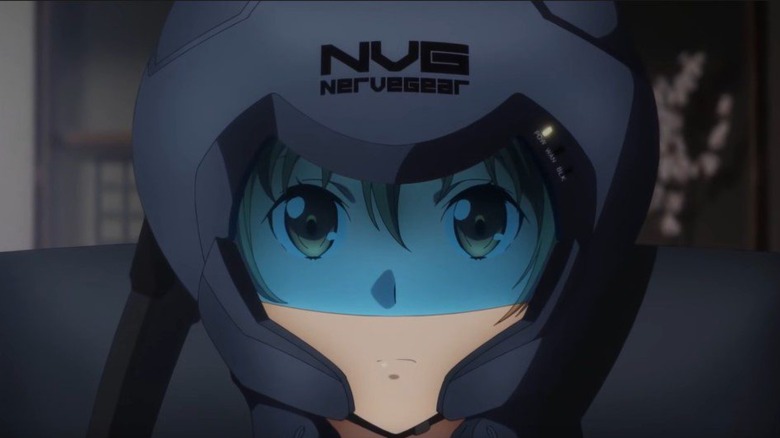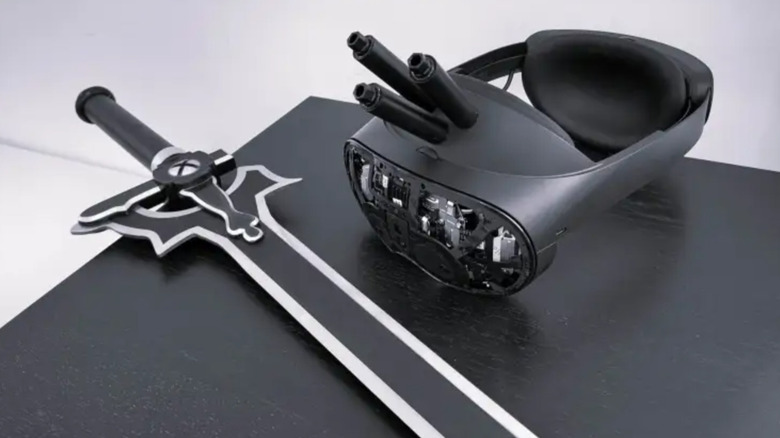Oculus Founder Creates VR Headset That Kills The User If They Die In The Game
In the wise words of one Dr. Ian Malcolm: "Your scientists were so preoccupied with whether they could, they didn't stop to think if they should."
Palmer Luckey, the founder of Oculus VR, announced that he has successfully created a prototype for a VR headset that can kill the user — like, actually kill them in real life — if they die within a game. "The idea of tying your real life to your virtual avatar has always fascinated me," Luckey wrote in a blog post detailing his creation. "You instantly raise the stakes to the maximum level and force people to fundamentally rethink how they interact with the virtual world and the players inside it."
The device, which Luckey includes a picture of in the post, generally resembles a typical VR headset such as the Meta Quest 2 or the Valve Index. However, viewers will quickly notice three conspicuous cylinders protruding right above where the user's forehead would be. According to Luckey, these are explosive charges that activate when they detect a "Game Over" screen in-game, "instantly destroying the brain of the user."
Naturally, the invention of such a piece of hardware invites some strong reactions, such as "What?," "Why?," and "I'm scared." As it turns out, there's more context behind Luckey's undeniably sinister new contraption that ties back to his days designing the original Oculus Rift. There are also some key details regarding the project that should relieve any readers who are concerned about encountering this device themselves any time soon.
Anime is to blame for the death headset
If you're an anime fan, you may have already noticed that Palmer Luckey's user-killing VR headset is just one or two steps removed from becoming the NerveGear device from the popular sci-fi series "Sword Art Online." The show follows several individuals who become trapped in a VRMMO game after learning that the NerveGear headset they're using to play will kill them if they die in-game or try to take it off. It's a fairly dark anime, and some fans have even decried certain "Sword Art Online" scenes that went too far.
The parallels between Luckey's grim invention and "Sword Art Online" are no coincidence. As the creator detailed in his blog post, he's been inspired by the franchise since before he started designing the original Oculus Rift. "The popularity of SAO led to massive otaku enthusiasm for Oculus, especially in Japan, which quickly became our 2nd largest market," Luckey wrote. "In turn, the existence of the Rift made SAO itself seem far more plausible and grounded." Notably, Luckey's announcement came on the same day that the events of "Sword Art Online" begin in-universe: November 6, 2022.
The headset's melding of VR technology and weaponry also stems from Luckey's expertise in both fields. The ex-Oculus exec is currently the head of Anduril Industries, a defense technology company that manufactures military weapons. He evidently put that experience to work on the headset's design, borrowing the explosive charges from "a different project" he's been working on. Swell.
What will happen to Luckey's murder VR?
While Palmer Luckey's new VR headset may bring the NerveGear from "Sword Art Online" to life, it's not a perfect recreation. As the creator wrote in his blog post: "There are a huge variety of failures that could occur and kill the user at the wrong time."
Seeing as such, Luckey admitted he hasn't tried the headset himself. The inventor noted that the product would need to host an advanced monitoring system to keep the death mechanism from wrongfully activating. "Something like this would need to be driven by a high intelligence agent that can reject false positives," he tweeted. "Too spooky otherwise!"
Still, more development time means that Luckey can make the device more advanced — and more deadly. The developer intends to create an anti-tamper mechanism so that the headset cannot be removed once worn, again reflecting its NerveGear counterpart. As for mirroring the NerveGear's lifelike VR, even cutting-edge headsets like the PSVR2 can't reach such a level yet. Luckey wrote that such a solution for his headset is years away, but that he's seeking to make it a (virtual) reality.
For now, the killer headset remains out of the public's reach. "At this point, it is just a piece of office art, a thought-provoking reminder of unexplored avenues in game design," Luckey concluded. "It is also, as far as I know, the first non-fiction example of a VR device that can actually kill the user. It won't be the last."



